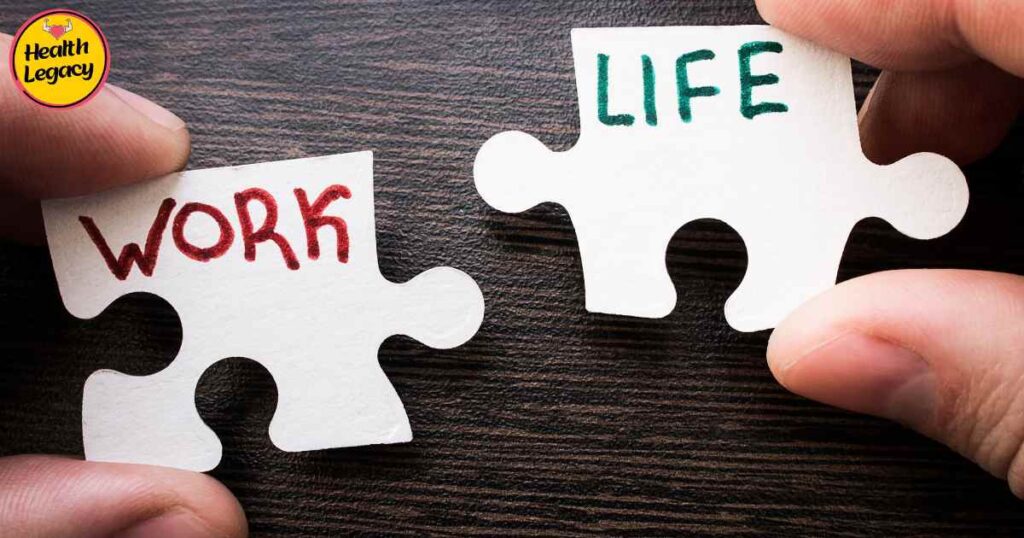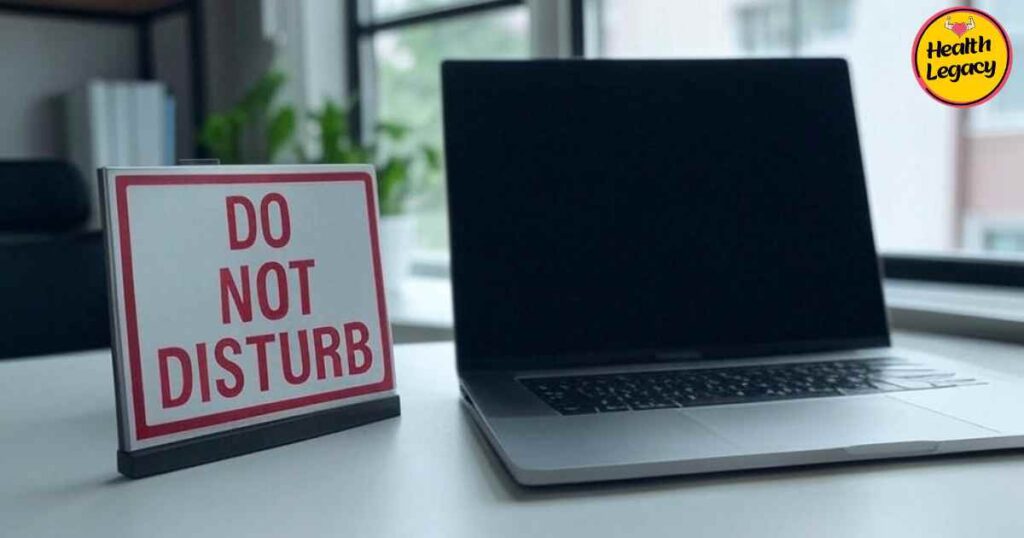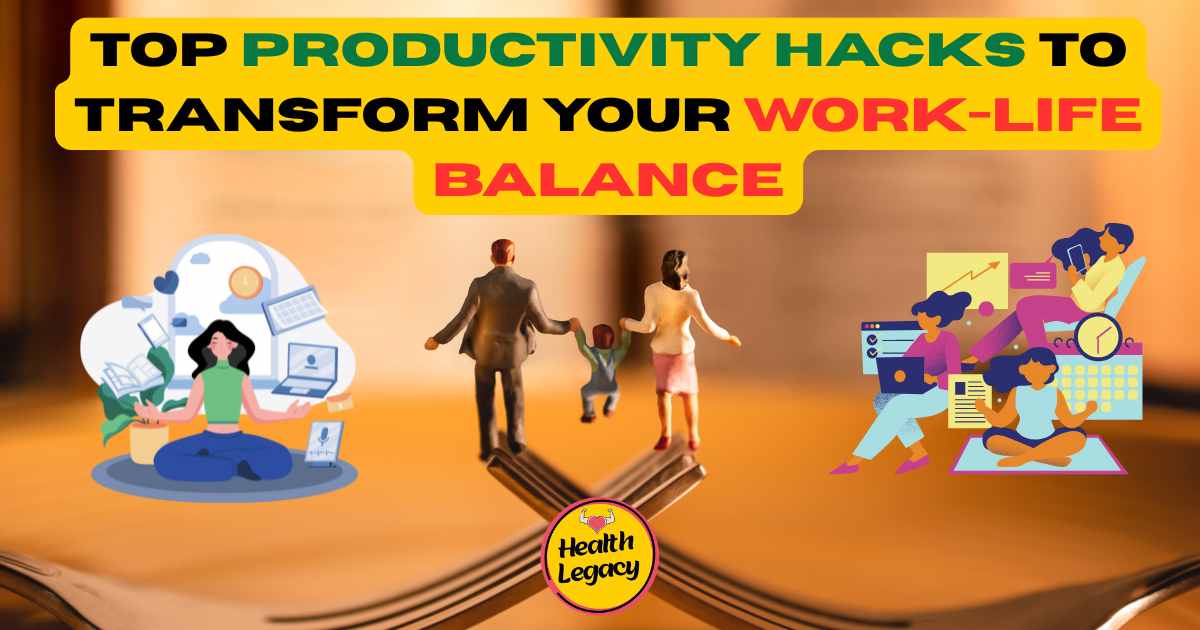Achieving Work-Life Balance: Tips and Trick
Ever feel like you’re juggling flaming torches while riding a unicycle? That’s what chasing work-life balance can feel like sometimes. Between deadlines, family duties, and the endless ping of notifications, it’s easy to feel like you’re dropping the ball.
But here’s the thing: balance isn’t about splitting your day into perfect halves. It’s about finding a rhythm that lets you shine at work and still have energy for what lights you up outside the office—whether that’s a quiet hike in the Rockies or a bustling Mumbai market.

At Health Legacy, we’re all about helping you live your best life, and that starts with nailing work-life balance. Our team, including health enthusiast and journalist Devanshi Priya, is passionate about sharing tips that actually work. In this guide, we’ll break down what work-life balance really means, why it’s a game-changer for your health and happiness, and how you can make it yours with simple, actionable steps. Let’s dive in!

What Is Work-Life Balance?
Work-life balance is like a well-tuned orchestra—each part plays its role without drowning out the others. It’s the sweet spot where your job and personal life coexist happily, letting you thrive in both. Think of it as giving your career the attention it needs while still carving out time for family, hobbies, or just chilling with a cup of chai.
Take Priya, a fictional software developer in Bangalore (purely for illustration). She codes like a pro during the day but still finds time to dance with her kids in the evening. That’s balance—work gets done, but life stays rich. It’s not about clocking out at 5 PM sharp every day; it’s about feeling fulfilled in all areas without burning out.
Also Read: Top 5 Best home workout routines for beginners, home fitness for newbies.
In today’s world, with remote work and smartphones, the lines between “on” and “off” can blur. Work-life balance helps you draw those lines clearly, so you can be present wherever you are—whether you’re closing a deal or enjoying a quiet moment by the Ganges.

Why Is Work-Life Balance Important?
A solid work-life balance isn’t just a nice-to-have—it’s a must for your well-being. Here’s why:
- Health: Overworking spikes stress, which can lead to anxiety, heart issues, or even a weakened immune system. Balance keeps you physically and mentally fit.
- Productivity: Ever notice how a good night’s sleep or a fun weekend makes Monday feel easier? Rested and happy, you’re more focused and creative at work.
- Relationships: Time with loved ones strengthens bonds. Neglecting them can leave you feeling isolated, even if you’re acing your job.
- Job Satisfaction: Balanced workers are happier and more likely to stick around, saving companies the headache of high turnover.
- Personal Growth: Hobbies, learning, or just daydreaming feed your soul and can even spark new ideas for work.

Stats back this up: 72% of job seekers say work-life balance is key when picking a job, and 57% would ditch a role that wrecks it (Zippia). At Health Legacy, we know balance is the secret sauce to thriving, not just surviving.

Common Challenges to Work-Life Balance
Achieving work-life balance isn’t always a walk in the park. Here are some hurdles you might face:
- Tech Overload: Smartphones mean work emails ping at midnight, making it hard to unplug.
- Heavy Workloads: Tight deadlines or big projects can eat into personal time, leaving you drained.
- Remote Work Woes: Working from home sounds dreamy, but 43% more remote workers clock over 40 hours a week compared to office folks (Zippia).
- Cultural Pressure: In some places, like high-pressure corporate hubs in India or the U.S., long hours are seen as dedication, pushing personal life aside.
- Family Duties: Caring for kids, parents, or even pets can squeeze out “me time.”
Also Read: Transform Your Life in 5 Simple Steps: The Ultimate Daily Wellness Routine
Knowing these challenges is half the battle. With the right strategies, you can tackle them head-on.

Strategies for Achieving Work-Life Balance
Ready to take control? Here are practical ways to nail work-life balance, packed with time management, stress management, boundary setting, and productivity hacks.

Time Management Tips
Good time management is your secret weapon. Try these:
- Prioritize Like a Pro: Use the Eisenhower Matrix to sort tasks by urgency and importance. Tackle what matters first.
- Set Goals: Know what you want at work and home. Break big goals into bite-sized steps.
- Plan Your Day: Use a planner or app like Trello to schedule work and fun, like a coffee date or gym session.
- Focus Up: Skip multitasking—it slows you down. Do one thing at a time for better results.
- Break It Up: Try the Pomodoro Technique: work 25 minutes, rest 5. It keeps you sharp and prevents burnout.
Imagine Arjun, a fictional coder in Bangalore (purely for example), who plans his day to code efficiently and still hit the local cricket pitch. That’s time management in action.

Stress Management Techniques
Stress management keeps you cool under pressure. Here’s how:
- Mindfulness Moments: Spend 5 minutes meditating daily to stay grounded. Apps like Headspace can guide you.
- Move Your Body: Exercise, like a brisk walk or yoga, releases endorphins. Aim for 30 minutes most days.
- Sleep Well: Stick to a sleep schedule. A cozy bedtime routine, like reading, sets you up for rest.
- Connect: Chat with friends or family. If stress piles up, a therapist can help.
- Do What You Love: Paint, cook, or hike—hobbies recharge you. Devanshi Priya swears by her evening runs to unwind.
These tricks lower stress, making balance easier to maintain.

Setting Boundaries
Boundary setting draws a clear line between work and life. Here’s how to do it:
- Stick to Work Hours: Set a cutoff, like 6 PM, and avoid work after unless it’s urgent.
- Create a Work Zone: If remote, use a dedicated desk, not your couch, to separate work from chill time.
- Speak Up: Tell colleagues and family when you’re “off” or need focus time.
- Say No: Don’t overcommit. Politely decline extra tasks that tip your balance.
Also Read: Boost Your Emotional Well-Being with These 10 Mental Health Strategies
Think of Maya, a fictional nurse in Chicago (for illustration), who turns off work notifications post-shift to enjoy family game nights. That’s boundary setting done right.

Productivity Hacks
Productivity hacks let you work smarter, not harder. Try these:
- Batch Tasks: Group similar jobs, like answering emails, to save mental energy.
- Tech Tools: Use apps like Asana to organize tasks or automate repetitive work.
- Delegate: Hand off tasks when you can, whether at work or home.
- Cut Distractions: Silence social media notifications or skip unnecessary meetings.
These hacks free up time for life outside work, like exploring a vibrant Indian festival or relaxing with a book.

The Role of Employers in Supporting Work-Life Balance
Employers can make a big difference in your work-life balance. Companies that get it right see happier, more productive teams. Here’s what they can do:
- Flexible Schedules: Letting workers choose hours or work remotely helps manage life’s demands. 81% of desk workers want this flexibility (Linearity).
- Time Off: Paid vacation or personal days, taken guilt-free, recharge employees.
- Wellness Support: Gym memberships or counseling services show care for health.
- Realistic Goals: Clear expectations prevent overload and burnout.
Also Read: Mindfulness Techniques for Beginners: Your Guide to Calm and Clarity 2025
At Health Legacy, we advocate for workplaces that prioritize balance, knowing it benefits everyone.

Conclusion
Nailing work-life balance takes effort, but it’s worth it. By mastering time management, practicing stress management, setting boundaries, and using productivity hacks, you can create a life where work and play coexist happily. It’s not about perfection but finding what works for you—maybe a morning jog in the Rockies or a quiet evening in a Mumbai flat.
Also Read: Top 10 Best Holistic Health Practices for Well-Being
At Health Legacy, we’re here to support you with tips and empathy, crafted by folks like Devanshi Priya, who lives for health and balance. Start small, tweak as you go, and watch your well-being soar. Here’s to a life where you thrive, not just survive!

Frequently Asked Questions (FAQs)
Q. How can I achieve work-life balance with a busy schedule?
Nailing work-life balance when your days are packed starts with smart time management. Prioritize tasks using a planner, set clear boundaries like no work emails after 7 PM, and sprinkle in stress management tricks like a quick walk or deep breathing. Small steps add up!
Q. What are the best time management strategies for work-life balance?
To rock time management for work-life balance, try the Eisenhower Matrix to focus on what matters, set daily goals, and use apps like Trello. Break tasks into chunks with Pomodoro timers—25 minutes of focus, 5 minutes of rest. You’ll get more done and still have time for fun.
Q. How does stress management improve my work-life balance?
Stress management is a game-changer for work-life balance. When you meditate for 5 minutes, hit the gym, or get solid sleep, you cut stress that drags you down. Less tension means more energy for work and life—think clearer and laugh louder!
Q. Why is boundary setting important for maintaining work-life balance?
Boundary setting keeps work-life balance intact by stopping work from spilling into your personal time. Say no to late-night calls, carve out a home workspace, and tell your team when you’re off-duty. It’s your shield against burnout and chaos.
Q. What productivity hacks can help me enhance my work-life balance?
Productivity hacks like batching emails, automating repetitive tasks with tools like Asana, and delegating chores can supercharge your work-life balance. You’ll free up hours to binge a show or sip chai without guilt—work smarter, not harder!
Also Read:
How to manage anxiety naturally-Expert Tips | Health Legacy
Transform Your Gut Health with These 7 Probiotic Diet Hacks!
How the Pioneer Woman Diet Plan Changed Ree Drummond’s Life
Erectile Dysfunction: A Silent Warning for Heart Health
Other Resources :




